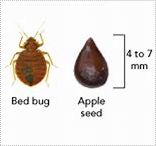
Bedbugs (Cimex lectularius) have become more prevalent in attached home communities. A bedbug problem in one unit can quickly become a problem for multiple units. Often an infestation becomes a dispute as to who is responsible for eliminating the problem.
Do We Have Bedbugs?
A big issue is that many residents do not recognize when there are bedbugs in their home. Thirty percent of people living with bedbugs don’t react to the bites and others believe the bites to be that of a mosquito or other insect. For these and other reasons, bedbugs are often not recognized early and therefore not treated until they become a big problem.
What Are Bedbugs Exactly?
A bedbug is a small bug that can be found anywhere. It is about a quarter of an inch long and resembles an apple seed.
Bedbugs are adaptive and can infest anywhere. There have been bedbug infestations in attached homes, apartments, movie theaters, hotels, college dorms, hospitals, clothing stores, and more.

They are quick and efficient reproducers. A female can lay up to 500 eggs in her lifetime. Eggs will hatch in one to two weeks and reach breeding maturity in five weeks.
How Do They Arrive?
Bedbugs are easily spread as they are excellent hitchhikers. They will crawl onto clothing, suitcases, furniture and other items and can be transported without being detected.
Once a bedbug finds a new home, it will hide in mattresses, box springs, furniture, vents, walls, ceilings, baseboards and electronics.
If their food source is eliminated, bed bugs will travel to find a new food source.
Why Have Bedbugs Made A Comeback?
According to the National Pest Management Association, bedbug calls have increased immensely in the last ten years. Entomologists and pest control professionals attribute their comeback to the banning of the pesticide DDT.
Bedbugs have also made a comeback due to international travel and an increase in secondhand merchandise and garage sales. Additionally, bedbugs seem to be moving more, going from room to room, and becoming active during the day.
Why Attached Homes And Their HOA Are At Risk?
To the bedbug, multi-unit housing complexes provide the ideal conditions for the insect’s survival. Plenty of furniture clutter and close living conditions provide limitless areas for bedbugs to hide, breed and evade the exterminator. Shared walls also make the spreading of the infestation easier.
Multi-unit housing complexes provide plenty of food as there are a large number of occupants living in close proximity. The higher the housing density in the community, the greater the risk the infestation will spread, and spread quickly.
Failure to take the necessary steps to eradicate an infestation will allow bedbugs to continue to multiply.

In extreme cases, some apartment complexes have had to be closed and sold because they were 50-90% infested and could no longer afford the tremendous costs of treatment. The same can happen in a condominium or attached community if the infestation is not timely addressed.
Who Is Responsible For Getting Rid Of An Infestation?
Like most states, Colorado does not have a state or statute law specifically targeted at bedbugs, nor do most association governing documents. However, check the declaration of covenants of the association for guidance first. If the declaration is silent, check-in with the association’s attorney.
Generally, the following applies (though the declaration may indicate other processes for treatment):
- Once treated in one home the bedbugs will frequently move to another home, a home that has not been treated.
- Accordingly, treatment by the association, through a contractor is recommended. The association should retain the services of a third party vendor that is capable of definitively determining the source of the infestation and the appropriate treatment.
A bedbug problem can also arise for an association when a unit owner with a known infestation refuses or fails to take steps necessary to address the infestation. In such cases, the association may need to act quickly to keep the infestation from spreading. The extent and manner of the association’s actions will depend on what is and is not authorized under the governing documents.

If the source is unknown or unclear, the association should treat the common elements and infested units at the association’s expense to avoid a problem that, ultimately, could cost the association thousands of dollars.
If an owner or resident does not comply with the association’s treatment, the association can file a lawsuit to request an order requiring the owner to comply. If the owner fails to comply with the court order, the association, with the assistance of the county sheriff, may enter the infested unit and have the unit treated to eliminate the infestation. Any costs incurred by the association to obtain the court order and treat the unit could be awarded to the association as part of the lawsuit.
What Is The Association’s Duty?
- Be Proactive:
- In order to avoid the problem altogether, associations should be proactive and budget for periodic inspections of homes in a condominium or attached housing community.
- The best control is inspection of common elements and units, especially in high-density communities.
- Act Quickly:
- If an owner reports bedbugs to the association, how the association deals with the infestation is critical. Associations should determine if the expense of extermination can be treated as a common expense. Check the declaration and consult with the association’s attorney.
- Disclose the infestation and plan of treatment.
- Educate Your Residents:
- It is important that all residents understand the importance of cooperating to keep bedbugs out of the community and how to treat them if they are discovered.
- Education is key to the association’s success in prevention of bedbug infestations.
- The association should consider community-wide distribution of educational materials, along with training in group settings to inform owners of the issues with bedbugs. One-on-one communication may be implemented as well.
How To Get Rid of Bedbugs.
Expert opinions vary. Many endorse heat treatments. Others still endorse pesticides. Check with a qualified expert. As always, obtain multiple opinions and bids and evaluate the best treatment plan.
Owners are recommended to take the following actions:
- Remove clutter where bedbugs can hide.
- Seal cracks and crevices.
- Vacuum rugs and upholstered furniture thoroughly under beds (take the vacuum bag outside immediately, and dispose in a sealed trash bag).
- Wash and dry clothing and bed sheets at high temperatures.
- Be alert, and monitor areas for bedbugs so they can be treated before a major infestation occurs.

Conclusion.
If everyone is aware of the possibility of a bedbug infestation, takes preventive measures and works together to formulate a unified approach to pest management, the association may be able to avoid the challenge of having to deal with the prevalent bedbug problem or could meet the challenge if bedbugs are found within the community.
Disclaimer
This article has been prepared by the HOA law firm of Orten Cavanagh Holmes & Hunt, LLC (the “Firm”) for general informational and educational purposes only. This article does not and is not intended to, constitute legal advice for any specific matter. The information in this article is not privileged and does not create an attorney-client relationship with the Firm or any of the Firm’s attorneys. This article is not an offer to represent any HOA or any other person. You should not act, or refrain from acting, based upon any information in this article. The hiring of an attorney is an important decision that should not be based solely on written information about qualifications or experiences. Anyone considering hiring an attorney should independently investigate the attorney’s credentials and ability and not rely upon advertisements or self-proclaimed expertise. To contact an attorney at the HOA law firm of Orten Cavanagh Holmes & Hunt, LLC visit us at our website and call or email one of our attorneys, contact us at info@ochhoalaw.com or call us at (720) 221-9780 or (719) 457-8420 or (888) 841-5149.


